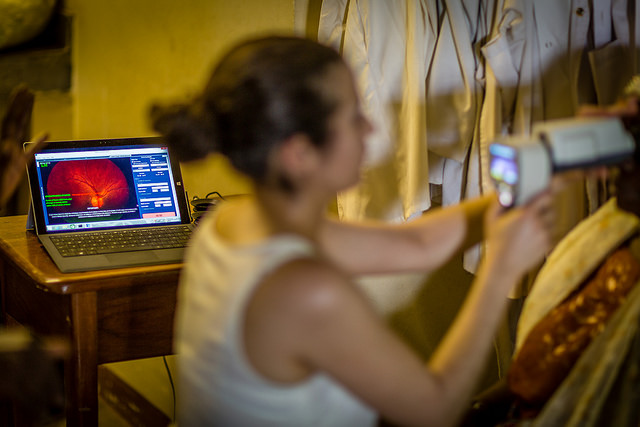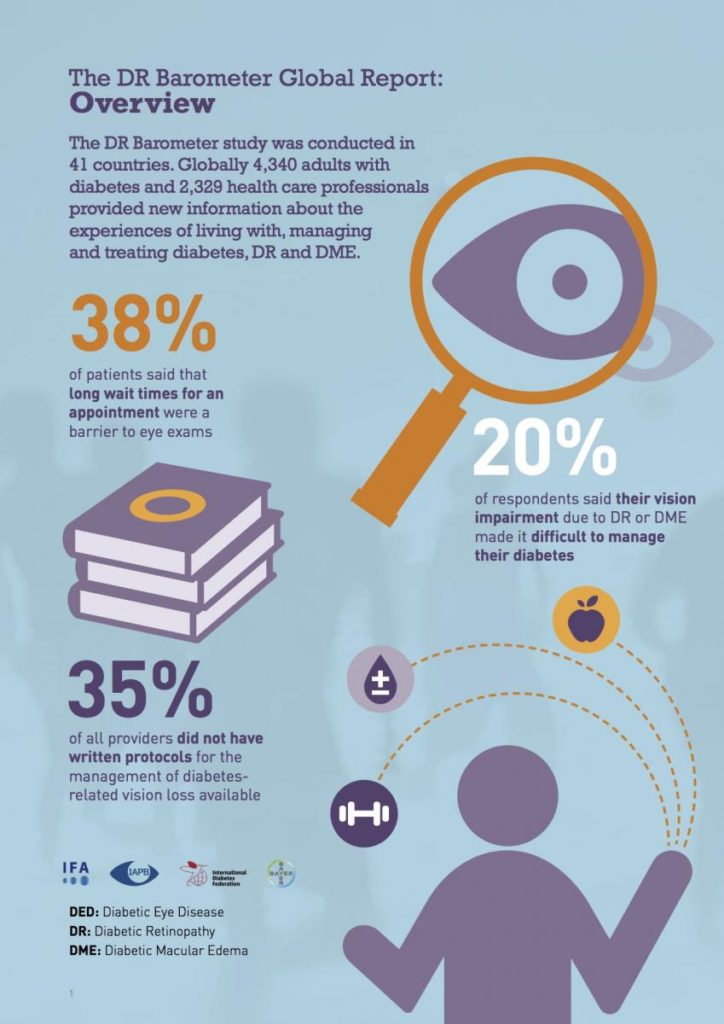Join a powerful, unprecedented alliance for better eye health for all.
Join IAPB-
Choose an alternate language here

Immediate release: Despite vision loss being feared twice as much as other common complications of diabetes (including cardiovascular disease and stroke) a quarter of people with diabetes surveyed are not discussing eye complications with their health care professional, with many presenting when vision problems have already occured.[simple_tooltip content=’The Diabetic Retinopathy Barometer Study: Global Findings. November 2016. Available at: www.drbarometer.com. Last accessed November 2016.’][/simple_tooltip] These are some of the concerning insights into the current management of diabetic retinopathy (DR) and diabetic macular edema (DME) revealed by the DR Barometer Study, launched today via a unique collaboration of experts from the International Federation on Ageing (IFA), International Diabetes Federation (IDF), International Agency for the Prevention of Blindness (IAPB) and Bayer Pharma AG.
The true impact of DR and DME was clearly highlighted throughout the DR Barometer Study, which shows that 79% of people with DR find that their vision loss makes activities such as driving, going to work and 
“Diabetic retinopathy is a leading cause of blindness in the working-age population of most developed countries and the sight loss caused by this condition can have a profound impact on both an individual’s quality of life and their ability to work,” said Peter Ackland, Chief Executive Officer, International Agency for the Prevention of Blindness (IAPB). “DR and DME can be successfully managed with the right screening and treatment, however many people with diabetes are being placed at unnecessary risk of vision loss due to barriers within the referral system and patient care pathway.”
The DR Barometer Study highlighted major capacity issues affecting access to eye examinations, which form a critical step in the detection and management of DR.[simple_tooltip content=’The Diabetic Retinopathy Barometer Study: Global Findings. November 2016. Available at: www.drbarometer.com. Last accessed November 2016.’][/simple_tooltip] This issue is clearly illustrated by the fact that both ophthalmologists and adults with diabetes who participated in the study reported ‘long waiting times to schedule an appointment’ as a major barrier to optimising eye health.[simple_tooltip content=’The Diabetic Retinopathy Barometer Study: Global Findings. November 2016. Available at: www.drbarometer.com. Last accessed November 2016.’][/simple_tooltip] One in three people with diabetes surveyed also confirm that even when they can book an appointment, the cost of the examination itself can be prohibitive, and 24% of patients said that waiting times at the clinic was a further issue.[simple_tooltip content=’The Diabetic Retinopathy Barometer Study: Global Findings. November 2016. Available at: www.drbarometer.com. Last accessed November 2016.’][/simple_tooltip]
As well as exposing inadequacies within health care systems, the DR Barometer Study uncovers a worrying lack of guidelines for health care professionals.[simple_tooltip content=’The Diabetic Retinopathy Barometer Study: Global Findings. November 2016. Available at: www.drbarometer.com. Last accessed November 2016.’][/simple_tooltip] It reveals that half of all providers surveyed do not have written protocols for the detection and management of diabetes-related vision issues.[simple_tooltip content=’The Diabetic Retinopathy Barometer Study: Global Findings. November 2016. Available at: www.drbarometer.com. Last accessed November 2016.’][/simple_tooltip]
The combined issues around capacity and cost for delivering screening, along with a lack of clarity around guidelines delivers a ‘perfect storm’ for this vulnerable population, both now and in the future; placing people with diabetes at risk of delays in diagnosis and treatment for diabetic eye disease. Close to two-thirds of ophthalmologists surveyed believe that late diagnosis is the greatest barrier to improving outcomes, with over half revealing that people with diabetes present when vision problems have already occurred and in many cases when it is too late for treatment.[simple_tooltip content=’The Diabetic Retinopathy Barometer Study: Global Findings. November 2016. Available at: www.drbarometer.com. Last accessed November 2016.’][/simple_tooltip]
“We are currently experiencing one of the most important demographic upheavals of our time in terms of global population ageing, and the impact of non-communicable diseases such as diabetes is rising at a rapid rate.” said Dr Jane Barratt, Secretary General, International Federation on Ageing. “The DR Barometer Study exposes numerous barriers to timely screening, diagnosis and treatment for many people with diabetes – barriers which must be addressed head-on if we are to more effectively manage the consequences of these diseases as the at-risk group increases. A patient’s age, where they live or how much they earn should not be the defining factors in determining the management and treatment of their diabetes or any associated complications, such as diabetic eye disease.”
Along with their detailed research findings, the IFA, IAPB and IDF have also harnessed the DR Barometer Study to deliver a number of key evidence-based recommendations to address the knowledge gaps and inequalities in services for people with diabetes.
One crucial element of good patient outcomes is regular, affordable and accessible eye examinations for people with diabetes, along with affordable treatment delivered within a co-ordinated system, to ensure those at risk of vision loss are effectively monitored and managed. The experts behind the DR Barometer Study are also calling for significantly increased education – both for people with diabetes and health care professionals – regarding the prevention, detection and treatment of DR and DME. Equally important is the provision of tools for people with diabetes in all countries to be able to effectively manage their diabetes and prevent vision loss from occurring in the first place.
“The theme of this year’s World Diabetes Day is ‘Eyes on Diabetes’, which reflects how critical we believe the role of eye health to be within diabetes management,” said Dr David Cavan, MD, Director of Policy & Programmes, International Diabetes Federation. “The DR Barometer Study offers a number of steps that need to be taken now to prevent further vision loss from diabetes and we urge governments around the world to seriously consider how current approaches to diabetic eye disease can be improved.”
For further information and to download the full results of the DR Barometer, please visit www.drbarometer.com
The DR Barometer short film from MHPC on Vimeo.
Diabetes remains one of the largest global public health concerns. The number of people with diabetes has nearly quadrupled since 1980 to 415 million adults.[simple_tooltip content=’IDF Diabetes Atlas, Seventh edition, 2015. International Diabetes Federation. Available at: www.diabetesatlas.org. Last accessed October 2016. WHO Global Report on Diabetes 2016. Available here.Last accessed October 2016.’][/simple_tooltip] DR, the most common form of diabetic eye disease, is a complication of diabetes caused by high blood glucose levels damaging the blood vessels at the back of the eye. DME is a frequent manifestation of DR, which occurs when blood vessels leak fluid into the retina, causing blurred vision. Both DR and DME can lead to blindness if undiagnosed and untreated. All people with type 1 and type 2 diabetes are at risk of developing DR and DME, which can be prevented via effective risk assessment, early diagnosis and appropriate management of diabetes.
To investigate the global, regional and specific country issues surrounding DR and DME, the International Federation on Ageing (IFA), the International Agency for the Prevention of Blindness (IAPB) and the International Diabetes Federation (IDF) conducted a comprehensive, two-phase, multi-country study. Phase one was a qualitative study comprising interviews in eight countries that represented a cross section of regions and income levels. Phase two was a quantitative study comprising desk research and the generation of new data from of a specifically designed, web-based survey of 4,340 adults with diabetes and 2,329 health care professionals in 41 countries. The study population of adults with diabetes who participated in the survey was self-selected, predominantly from patient organisations as well as membership organisations of older adults (seniors). Therefore, this population group comprises people who are more likely to be engaged and motivated in the management of their diabetes. Likewise, the health care professionals (providers) are self-selected and the same principle should be applied when interpreting the results.
The International Federation of Ageing (IFA) is an international non-governmental organisation (NGO) with a membership base comprising government, NGOs, industry, academia and individuals in 70 countries. IFA is a voice alongside and on behalf of older adults globally and has General Consultative Status at the United Nations and its agencies including the World Health Organisation. For further information visit: https://www.ifa-fiv.org/
The International Diabetes Federation (IDF) is an umbrella organisation of over 230 national diabetes associations in 170 countries and territories. It represents the interests of the growing number of people with diabetes and those at risk. The Federation has been leading the global diabetes community since 1950. For further information visit: http://www.idf.org/
The International Agency for the Prevention of Blindness (IAPB) is the coordinating membership organisation leading international efforts in blindness prevention activities. IAPB’s mission is to eliminate the main causes of avoidable blindness and visual impairment by bringing together governments and non-governmental agencies to facilitate the planning, development and implementation of sustainable national eye care programmes.
This research was made possible with support from Bayer Pharma AG. Bayer has funded and facilitated this research, acted as an advisor and will assist in the dissemination of the research findings. Bayer is a global enterprise with core competencies in the Life Science fields of health care and agriculture. Its products and services are designed to benefit people and improve their quality of life. At the same time, the Group aims to create value through innovation, growth and high earning power. Bayer is committed to the principles of sustainable development and to its social and ethical responsibilities as a corporate citizen. For more information, go to www.bayer.co.uk